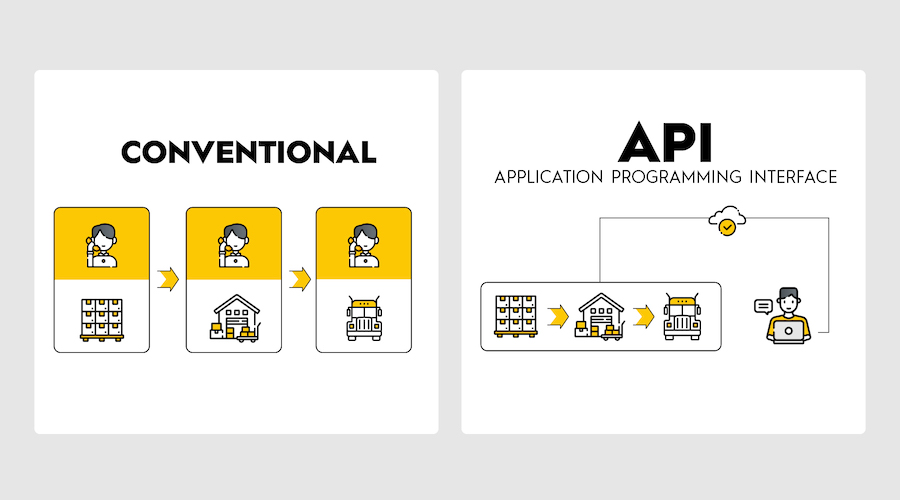
Introduction to API Pricing in Transportation
May 30, 2023

API (Application Programming Interface) pricing is revolutionizing the transportation industry by automating the process of pricing orders, eliminating the need for negotiation, and simplifying the tendering process.
Anyone in the transportation industry knows how time-consuming and tedious it can be to get quotes, enter data manually into multiple platforms, and settle billing discrepancies with providers via email or phone. API pricing involves a demand call from a customer system to the carrier system, where the carrier system responds to the order based on the customer’s specified parameters.
Shippers can connect their in-house technology to a carrier or freight provider’s API. By doing so, they can reduce errors, increase speed from quote to shipment, eliminate the need to onboard new software, and receive real-time tracking updates. Still, several factors must be considered in how and when to utilize API.

Benefits Of Api Pricing In The Transportation Industry
- Automated pricing
- Increases speed: By automating the communication between your system and your provider’s system, API integration can significantly reduce the time it takes to get quotes and move shipments. Eliminating the need for negotiation accelerates the entire process.
- Lower customer cost is possible through hard and soft savings by conserving resources.
- Eliminates manual processes
- Reduces errors: Manual data entry is error-prone, and mistakes can be costly in the transportation industry. API integration eliminates the need for manual data entry, reducing the risk of errors.
How Api Pricing Works In The Transportation Industry
API pricing involves connecting a shipper’s in-house technology to a carrier or transportation provider’s API. This integration allows direct communication between the shipper’s and provider’s systems, enabling real-time access to pricing information and other dynamic features.
API pricing works by utilizing the data and algorithms of the freight provider to generate accurate and up-to-date pricing information based on the shipment’s specific details, such as:
- The origin and destination locations
- The weight and dimensions of the cargo
- The mode of transportation
The shipper’s system can access this information in real-time through API integration, enabling them to quickly compare prices across multiple providers and select the most cost-effective option for their needs.

Subscribe!
Subscribe to receive the latest articles, newsletters, whitepapers, and industry news directly to your inbox.
"*" indicates required fields
Integrating API
To set up API integration, ask your provider if their API offers native integration with your current software. If not, there are third parties to help with coding and development. Once you’ve integrated your systems, there are some things you should keep in mind to ensure it continues to function optimally.
Maintaining Optimal Functionality
By following these tips, you can ensure you’re getting the most out of your API integration:
- Stay up to date on the freight market.
- Be clear and upfront about your expectations.
- Track and analyze your results.
- Establish automated communication and updates with your provider, customer, and/or carrier.
WHEN DOES API PRICING MAKE SENSE?
Here are a few scenarios where it might make sense for a shipper to utilize API pricing:
- Shippers with a high volume of shipments: If a shipper has a high volume of shipments, it can be time-consuming to request quotes from multiple carriers or providers manually. Utilizing API pricing can help streamline the process and save time.
- Shippers who want to compare rates quickly: If a shipper needs to decide quickly, API pricing can provide real-time rates and quotes, allowing the shipper to compare prices and make an informed decision promptly.
- Shippers who want to remain lean: If a shipper seeks to remain lean in their department, API allows their team to save resources to focus on other business opportunities.

When does API pricing NOT make sense?
Here are a few scenarios where API pricing may NOT be a good fit:
- Shippers with a low volume of shipments: If a shipper has a low volume of shipments, it may not be worth the investment in technology and infrastructure required to support API pricing. In this case, manually requesting quotes from carriers or providers may be more practical and cost-effective.
- Shippers with a narrow scope of carriers or providers: API pricing may be unnecessary if a shipper only works with a few specific carriers or providers. In this case, the shipper may already have established pricing agreements with their preferred carriers or providers and may not need to compare rates from other sources.
THE BUSINESS ETHICS OF API PRICING
API pricing is a newer technology, and like all innovations, some may exploit it to their advantage. For example, a large shipper may compare special low-volume rates with those received via API and choose the cheaper option, regardless of their relationship with providers and carriers. This practice has raised concerns in the industry, and solutions for mutually beneficial rules of engagement are imperative.
API pricing is a powerful tool for shippers and transportation providers in the logistics industry. By enabling real-time access to pricing information and other dynamic features, API integration can help streamline the freight transportation process and drive greater efficiency and cost savings. However, it is crucial to consider the technical and financial implications and ensure that all parties agree on mutually beneficial protocols.
Interested in learning more about API pricing? Contact us today!

